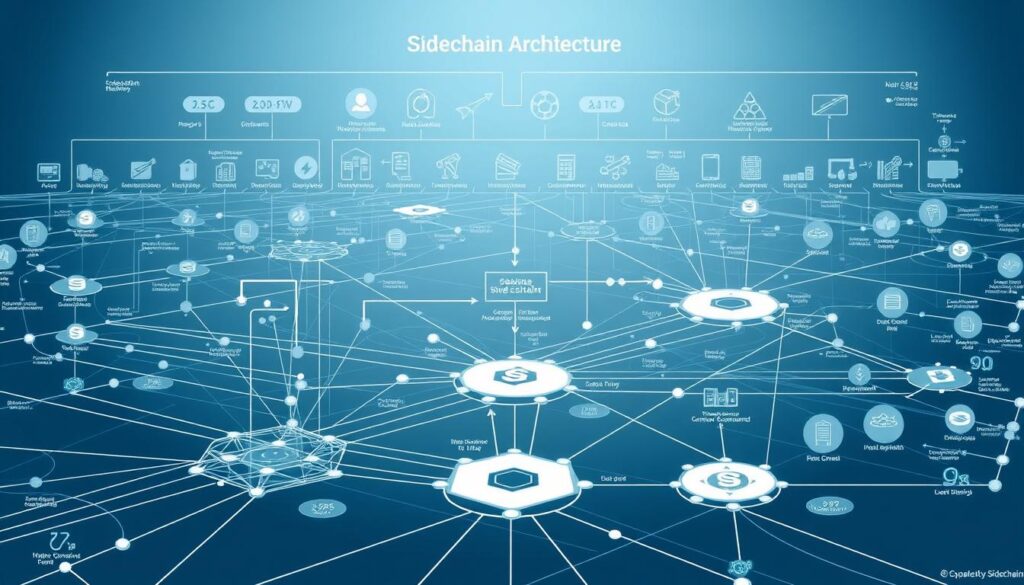Now Reading: Blockchain layer two scaling network: Scalability Solutions
- 01
Blockchain layer two scaling network: Scalability Solutions
Blockchain layer two scaling network: Scalability Solutions

Major distributed ledger systems face a critical challenge as they grow. The very success that makes them valuable also creates bottlenecks. These systems promise security and decentralization, but their capacity struggles to keep up with demand.
Ethereum hit a record 2 million daily transactions in January 2024. This explosion in activity spans decentralized finance, digital collectibles, and gaming applications. The growth has pushed foundational networks to their operational limits, revealing significant constraints in processing capacity and cost efficiency.
Secondary protocols built atop existing chains offer a powerful answer. These innovative approaches dramatically increase transaction throughput while preserving the security benefits of the underlying technology. They represent the primary method for enhancing performance without compromising core principles.
According to L2Beat, these secondary networks now process 11-12 times more transactions than Ethereum’s main chain. This results in substantially lower fees and faster confirmation times. The transformative impact on overall system performance is undeniable.
Key Takeaways
- Major distributed ledger systems face significant capacity constraints as adoption grows
- Ethereum reached 2 million daily transactions in January 2024, highlighting scaling challenges
- Secondary protocols built on existing chains dramatically increase transaction capacity
- These solutions process 11-12 times more transactions than main chains while reducing costs
- The technology maintains security and decentralization while improving performance
- This guide explores how these scaling approaches work and their real-world applications
- Understanding these solutions is essential for mainstream adoption of distributed systems
Introduction: Scaling Challenges in the Blockchain World
A significant gap exists between traditional payment systems and decentralized transaction networks in terms of processing speed. This difference creates real-world limitations for everyday users.
The Growing Demand for Faster Transactions
Over 420 million people now own cryptocurrency worldwide. This massive user base creates unprecedented demand for transaction processing.
Traditional systems like VisaNet handle approximately 20,000 transactions per second. In contrast, Bitcoin’s main chain processes only 3-7 transactions during the same time period.
Understanding the Scalability Trilemma
Distributed systems face what’s known as the scalability trilemma. This concept describes the challenge of achieving three key properties simultaneously.
Networks must balance security, decentralization, and scalability. Most foundational systems prioritize the first two properties, which naturally limits transaction throughput.
| System Type | Transactions Per Second | Key Focus | Tradeoffs |
|---|---|---|---|
| Centralized (Visa) | ~20,000 TPS | Speed & Efficiency | Limited decentralization |
| Decentralized (Bitcoin) | 3-7 TPS | Security & Trust | Lower transaction capacity |
| Ethereum Mainnet | 15-30 TPS | Decentralization | Higher fees during peaks |
This architectural choice ensures tamper-proof transactions and distributed control. However, it creates bottlenecks when user numbers increase rapidly.
Without effective solutions, these limitations could hinder mainstream adoption. The growing complexity of applications further exacerbates these challenges.
Layer 1 vs. Layer 2 Blockchain Solutions
Modern decentralized networks operate through complementary layers that serve distinct but interconnected purposes. These architectural approaches work together to balance performance with fundamental security principles.
Defining Layer 1: Security and Decentralization
Layer 1 protocols form the foundational base of distributed systems like Ethereum and Bitcoin. These independent networks maintain their own data availability and consensus mechanisms.
Every transaction processes directly on the main chain through a network of participating nodes. This approach prioritizes robust security and complete decentralization by requiring universal verification.

Defining Layer 2: Enhancing Throughput and Efficiency
Layer 2 solutions build upon existing Layer 1 blockchain infrastructure to improve performance. They handle transaction execution off-chain while maintaining the underlying security guarantees.
These protocols submit compressed summaries back to the base chain for final settlement. This dramatically increases transaction throughput while reducing costs for end users.
The relationship between these layer approaches is complementary rather than competitive. Layer 2 enhances Layer 1 capabilities without compromising core decentralization principles.
Key Benefits of Blockchain layer two scaling network
The practical benefits of these enhanced protocols create tangible improvements for everyday users and developers. These advantages make decentralized systems more accessible and efficient for widespread use.
Enhanced Transaction Throughput and Lower Fees
Secondary solutions dramatically increase processing capacity by handling work away from the main system. This approach allows networks to manage significantly more transactions per second.
By grouping multiple operations together, these protocols maximize efficiency. They submit compressed summaries to the base system, reducing the computational burden.
Users experience substantial fee reductions as gas costs decrease dramatically. This makes applications affordable for regular use without compromising security.
The system supports microtransactions and frequent trades that were previously impractical. Lower costs remove a major barrier to adoption for millions of users.
Near-instant confirmation times enable real-time applications like trading and gaming. Faster processing creates a competitive user experience while maintaining decentralization principles.
Deep Dive into Layer Two Technologies: Rollups, State Channels, and Sidechains
Several distinct technological approaches have emerged to address the performance limitations of foundational distributed systems. These methods—rollups, state channels, and sidechains—each offer unique mechanisms for boosting transaction capacity.
They handle the bulk of transaction processing away from the main network. This fundamental shift is key to achieving higher throughput and lower fees.

Exploring Rollups: Optimistic and Zero-Knowledge
Rollups are a leading solution that executes transactions off-chain. They bundle hundreds of operations into a single, compressed data package.
This bundle is then submitted back to the main chain for final settlement. This process drastically reduces the data burden on the base network.
Optimistic rollups operate on a trust-but-verify model. They assume all transactions are valid by default.
A challenge period allows anyone to submit fraud proofs if they detect invalid activity. Prominent examples include Arbitrum, Optimism, and Base.
Validity rollups, also known as zero-knowledge (ZK) rollups, use advanced cryptography. They generate a mathematical proof for each transaction batch to verify correctness.
Starknet is a leading example, offering confirmation times of about two seconds and very low fees. Other ZK rollups include zkSync and Polygon zkEVM.
Understanding State Channels and Sidechains
State channels enable direct, off-chain interactions between participants. Users lock funds into a multi-signature smart contract to open a channel.
They can then conduct an unlimited number of instant transactions between themselves. Only the final state is recorded on the main chain when the channel closes.
The Lightning Network for Bitcoin is the most famous state channel example. It can theoretically process around one million transactions per second.
Sidechains are independent networks connected to a main chain via a two-way peg. They have their own consensus mechanisms and validators.
This allows for high flexibility and experimental features. The Liquid Network for Bitcoin and Polygon are key examples.
However, sidechains require trust in their own security model, as they do not inherit full security from the base chain directly.
| Technology | Primary Mechanism | Key Advantage | Example |
|---|---|---|---|
| Rollups | Off-chain execution, on-chain data posting | Strong security inheritance | Arbitrum, Starknet |
| State Channels | Bi-directional off-chain payment channels | Near-instant finality, extreme throughput | Lightning Network |
| Sidechains | Independent chain with two-way peg | Flexibility and custom rules | Polygon PoS |
Real-World Impact: Applications and Use Cases
The true value of any technological advancement becomes clear when we see its practical applications in everyday life. Secondary protocols are now powering revolutionary changes across multiple industries.
These implementations demonstrate how enhanced throughput and reduced costs create tangible benefits for millions of users worldwide.
Decentralized Finance, NFTs, and Onchain Gaming
Decentralized exchanges built on secondary protocols offer dramatically improved trading experiences. Users enjoy faster order execution and significantly lower fees compared to main chain alternatives.
This makes financial services accessible to retail participants who were previously priced out. The entire DeFi ecosystem benefits from more efficient lending, borrowing, and yield farming operations.

Digital collectibles and gaming applications have undergone similar transformations. Minting NFTs becomes affordable rather than prohibitively expensive.
Seamless in-game microtransactions enable new gameplay mechanics without friction. These improvements make blockchain-based services competitive with centralized alternatives.
Practical Examples in Payments and Micropayments
The Lightning Network demonstrates how secondary solutions enable practical payment applications. It facilitates instant, low-cost Bitcoin transactions for everyday use.
Innovative concepts like streaming payments become economically viable. Major applications have already migrated to leverage these benefits.
Uniswap V3 launched on Optimistic Ethereum in July 2021. Arbitrum One followed in August 2021, showing real-world adoption by top applications.
These implementations maintain security through smart contract validation while serving millions of users. They unlock business models previously impossible due to economic constraints.
Navigating the Scalability Trilemma in Blockchain
Distributed systems face a fundamental architectural challenge known as the scalability trilemma. This concept suggests that achieving optimal security, complete decentralization, and high scalability simultaneously remains extremely difficult.

Security ensures transactions are tamper-proof. Decentralization maintains distributed control without central authorities. Scalability enables high-volume processing measured in transactions per second.
Balancing Security, Decentralization, and Scalability
Different networks prioritize these properties differently. Ethereum initially emphasized security and decentralization with 500,000 validators, limiting throughput.
In contrast, BNB Chain operates with only 21 validators. This design trades some decentralization for faster transaction speeds.
The architecture requiring every transaction to be verified by numerous nodes inherently restricts throughput. This creates the fundamental limitation developers must address.
Strategies to Overcome Network Limitations
Several Layer 1 approaches help mitigate these constraints. Changing consensus mechanisms is one primary strategy.
Ethereum’s transition from proof-of-work to proof-of-stake increased efficiency. This change supported faster speeds with reduced energy consumption.
Sharding breaks authentication workloads into smaller pieces. This distributes tasks across the network for faster block completion.
Chain forks provide upgrade mechanisms. Bitcoin’s SegWit soft fork increased capacity from 1,600 to nearly 3,000 transactions per block.
| Solution Type | Primary Mechanism | Impact on Trilemma | Example |
|---|---|---|---|
| Consensus Change | Altering validation methodology | Improves scalability & security | Ethereum PoS transition |
| Sharding | Dividing workload across nodes | Enhances throughput capacity | Ethereum’s roadmap |
| Chain Fork | Protocol upgrade implementation | Increases processing efficiency | Bitcoin SegWit |
While these Layer 1 solutions help, they require high consensus among operators. This makes implementation slow, highlighting why secondary protocols have become essential for meaningful improvements.
Emerging Innovations in Layer Two Scaling Solutions
Cutting-edge developments are reshaping how secondary networks enhance distributed system performance. The landscape continues to evolve with hybrid approaches and advanced cryptographic techniques.
These innovations address complex challenges while maintaining the security foundations of primary chains. They represent the next generation of optimization for decentralized applications.
Advances in Zero-Knowledge Rollups and Hybrid Approaches
Hybrid solutions combine the best features of different scaling technologies. They integrate rollup efficiency with state channel speed for versatile performance.
Breakthroughs in validity proofs like STARK technology enhance both scalability and privacy. This enables networks to handle increasingly complex computational use cases effectively.
The focus on cross-chain interoperability is critical for creating unified ecosystems. Standardized protocols prevent liquidity fragmentation across multiple chains.
Future Trends and Development Roadmaps
Tailored solutions optimized for specific industries make the technology more accessible. Healthcare data management and supply chain tracking benefit from customized approaches.
Multi-layered architecture introduces chains operating atop existing networks. This provides dedicated infrastructure for niche applications and enhances customization.
Applications designed specifically for these environments bypass primary chain limitations entirely. This evolution makes layer 2 blockchain investments increasingly attractive for high-frequency use cases.
The vision positions secondary networks as the primary execution layer for user interactions. Primary chains transition to secure settlement and data availability roles in this optimized stack.
Optimizing Performance: Addressing Layer Two Limitations
While secondary protocols offer significant performance improvements, they introduce new operational challenges that require careful consideration. Developers face increased complexity when working with these enhanced systems.
Security trade-offs exist despite inheriting protection from the main chain. Additional components like fraud proof systems and bridge smart contracts can create new vulnerability vectors.
Mitigating Liquidity Fragmentation and Interoperability Issues
Liquidity fragmentation occurs when assets become isolated across multiple chains. This reduces capital efficiency and complicates asset movement throughout the ecosystem.
Cross-chain bridges and interoperability protocols help address this fragmentation. They enable seamless transfers between different networks and create unified liquidity pools.
These solutions depend on the base chain for final settlement and security. Main chain congestion or downtime can disrupt their performance and execution capabilities.
Data availability remains critical for maintaining system integrity. Offchain transaction information must stay accessible to all nodes at all times.
Specialized storage protocols and data sampling techniques ensure reliable access. They minimize the processing burden on the primary network while preserving security.
State synchronization between networks and the main chain is essential. Advanced consensus protocols and state roots help maintain alignment for seamless communication.
Fraud prevention requires robust dispute resolution mechanisms. These include challenge periods, watchtower services, and cryptographic proof systems that protect against invalid transactions.
Conclusion
Secondary scaling solutions have transformed from experimental concepts to essential components of modern blockchain architecture. These protocols deliver faster transaction processing and significantly reduced fees while preserving the core security of base systems.
The real-world impact is evident across decentralized finance, digital collectibles, and payment applications. These technologies make blockchain competitive with centralized alternatives in user experience.
While challenges like liquidity fragmentation exist, ongoing innovations in cross-chain protocols and cryptographic proofs address these limitations effectively. The ecosystem continues to evolve with each advancement.
The question is no longer whether these solutions will succeed but how far they will push mainstream adoption. Continued development remains central to creating accessible, efficient decentralized technology for users worldwide.
FAQ
What is a layer two scaling network?
A layer two scaling network is a secondary framework built on top of a primary blockchain, like Ethereum or Bitcoin. Its main goal is to increase the number of transactions per second and reduce fees by handling activity off the main chain, while still leveraging its base security and decentralization.
How do rollups improve scalability?
Rollups bundle, or “roll up,” many transactions into a single piece of data that is posted to the main chain. This process dramatically increases throughput. There are two main types: Optimistic Rollups, which assume transactions are valid, and Zero-Knowledge Rollups, which use cryptographic proofs for immediate finality.
What are the key differences between state channels and sidechains?
State channels are like private pathways where participants can transact many times off-chain, settling the final state on the mainnet. Sidechains are independent blockchains with their own consensus mechanisms that run parallel to the main chain, offering high throughput but often with different security assumptions.
Why are lower transaction fees a major benefit of layer two solutions?
By processing transactions outside the congested main chain, these networks reduce the competition for block space. This efficiency leads to significantly lower gas fees for users, making activities like decentralized finance (DeFi) and NFT trading more accessible.
How do layer two networks impact security?
Most layer two solutions inherit their security from the underlying layer one blockchain. For example, funds in a rollup are ultimately secured by Ethereum’s validators. However, some approaches, like certain sidechains, have their own independent security models, which can vary in robustness.
What is the scalability trilemma?
The scalability trilemma describes the challenge of achieving high scalability, strong security, and true decentralization simultaneously in a single network. Layer two scaling networks are a primary strategy to overcome this by boosting throughput without compromising the core security and decentralization of the base layer.
Can you give a real-world example of a layer two solution?
A prominent example is the Lightning Network for Bitcoin, which enables instant, low-cost payments through a network of payment channels. For Ethereum, Arbitrum and Optimism are leading Optimistic Rollup solutions that power many DeFi and gaming applications.














